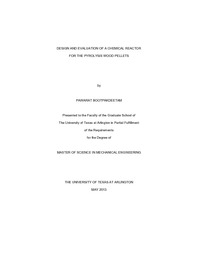
ATTENTION: The works hosted here are being migrated to a new repository that will consolidate resources, improve discoverability, and better show UTA's research impact on the global community. We will update authors as the migration progresses. Please see MavMatrix for more information.
Show simple item record
| dc.contributor.author | Bootpakdeetam, Pawarat | en_US |
| dc.date.accessioned | 2013-07-22T20:13:18Z | |
| dc.date.available | 2013-07-22T20:13:18Z | |
| dc.date.issued | 2013-07-22 | |
| dc.date.submitted | January 2013 | en_US |
| dc.identifier.other | DISS-12239 | en_US |
| dc.identifier.uri | http://hdl.handle.net/10106/11794 | |
| dc.description.abstract | Currently there is interest in converting waste biomass into valuable products, such as fuels and specialty chemicals. However, the product composition, yield, the energy required to run the reaction, and the required residence time are all factors influence the economics of the process. Estimate of these factors at the laboratory scale is important for evaluating whether a pilot or demonstration scale study is warranted. In this work, a bench-scale chemical reactor was designed and constructed to conduct the batch pyrolysis of pelletized biomass. The reactor was tested using pine wood pellets as the feedstock. The feedstock weight to reactor volume ratio was varied to see the impact on required energy input, product yield, composition, and distribution, and conversion time. The products were collected and characterized. Mass and energy balance calculations were performed as well. The products from pyrolysis experiment, bio-oil, bio-char, and gases were collected during the experiment. The liquids and gases were analyzed by gas chromatography (GC). Simulated distillation was performed on the oil by GC to determine boiling point distributions. The char was characterized by TGA and element analysis. Thermal losses of the system were determined through energy balance to give an estimation of thermal efficiency. The energy value of the products was estimated using data obtained from the literature. In additional the chemical kinetics of the reaction were also investigated. The Arrhenius equation was introduced into this experiment in order to understand and the rate of evolution of products from the pyrolysis reaction. The empirical data from Thermogravimetric analysis (TGA) and Differential Scanning Calorimetry (DSC) were used to determine reaction rate constant and the calorific requirements for the reaction. The TGA data also guided the choice of maximum reactor temperature. | en_US |
| dc.description.sponsorship | Dennis, Brian | en_US |
| dc.language.iso | en | en_US |
| dc.publisher | Mechanical Engineering | en_US |
| dc.title | Design And Evaluation Of A Chemical Reactor For The Pyrolysis Wood Pellets | en_US |
| dc.type | M.Engr. | en_US |
| dc.contributor.committeeChair | Dennis, Brian | en_US |
| dc.degree.department | Mechanical Engineering | en_US |
| dc.degree.discipline | Mechanical Engineering | en_US |
| dc.degree.grantor | University of Texas at Arlington | en_US |
| dc.degree.level | masters | en_US |
| dc.degree.name | M.Engr. | en_US |
Files in this item
- Name:
- Bootpakdeetam_uta_2502M_12239.pdf
- Size:
- 2.325Mb
- Format:
- PDF
This item appears in the following Collection(s)
Show simple item record


